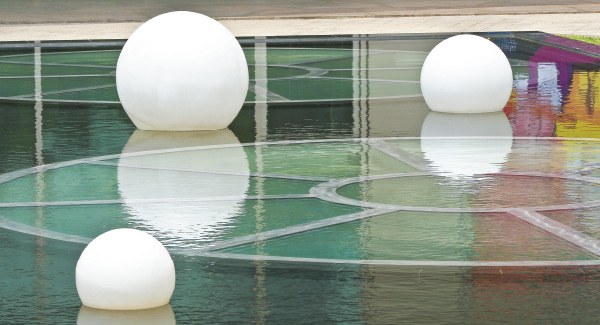
No other element can describe calmness better than a clean, smooth sheet of water. Even the slightest breeze creates soothing ripples, which brings out an inner sense of peace and serenity. But the introduction of this type of water feature needs to match the function of the space. For example, if we have a courtyard filled with activity, a still water feature may contradict the intended use of the space. Still water should be used for areas that require calm such as a meditation courtyard or sanctuary.Other enhancers may be introduced through the use of sculptural lights to create a soft glow within the still water to further enhance the effects of peace.
 To create vibrancy and energy, there is no better method than introducing a multiple-level waterfall effect. However, the secret to creating a multiple-level water feature is not to have all the levels cascade down in a short span but rather to stagger the levels where each waterfall drops down gently in the beginning until the finale, which has a larger cascade. By doing so, we are able to tap into our sense of sound, where the sound of water starts off gentle, turning into a larger roar, thus creating excitement and suspense.This type of feature is ideal for a large gathering space, as it complements the need for energy and activity; so consider this type of water feature for the landscaped garden or a public gathering space.
To create vibrancy and energy, there is no better method than introducing a multiple-level waterfall effect. However, the secret to creating a multiple-level water feature is not to have all the levels cascade down in a short span but rather to stagger the levels where each waterfall drops down gently in the beginning until the finale, which has a larger cascade. By doing so, we are able to tap into our sense of sound, where the sound of water starts off gentle, turning into a larger roar, thus creating excitement and suspense.This type of feature is ideal for a large gathering space, as it complements the need for energy and activity; so consider this type of water feature for the landscaped garden or a public gathering space.

How we design our water features can affect how we perceive a space. By creating a long narrow feature, it helps break the monotony of the garden, but it also brings attention to itself thereby making the water feature the key element in the overall space. The next effect it has is how our viewpoint gets drawn away from the peripheral to the far end, thereby pulling our sensory experience from one end of the garden to the other.By creating a long water run, we start to experience the pleasure of Movement, as we are drawn to move with the water, as if to travel down a designated path in order to experience of the landscape.
SOCIAL Center of Activity
 Fountains play a vital role in society as there are no better installations able to attract people from all walks of life together into a single space. The key element is how to tap into each individual sensory organ and have it culminate into a single physical object. With sight, fountains tend to encompass an overpowering sculptural effect, and set within a large plaza, it stands out, thereby telling our visual perception that the fountain is the main feature of the space.
Fountains play a vital role in society as there are no better installations able to attract people from all walks of life together into a single space. The key element is how to tap into each individual sensory organ and have it culminate into a single physical object. With sight, fountains tend to encompass an overpowering sculptural effect, and set within a large plaza, it stands out, thereby telling our visual perception that the fountain is the main feature of the space.
With sound, fountains are designed to maximize the cascading effect of water, usually dropping water from substantial heights to create the maximum audible effect achievable without spillage. And finally, the sense of touch, where you will notice in most fountains there is a base pool that collects and recycles water. But it also serves as a means for people to congregate around the space to touch and feel water, so by combining these 3 sensory effects, you will find that the fountain is the ultimate water feature in creating social interaction.

Now that we have identified how water can affect our senses, we need to then look at ways to integrate water with the other elements. Water being the most malleable material will serve to be the most prominent element in the feature. For example, the sculptural water feature combines the element of water, metal and fire in one installation. The secret is to balance the size of the metallic feature with the size of the pool.
By creating a cascading effect, water is merged with the metal sculpture to combine both elements together rather than one element sitting onto another. With bright uplights, the element of fire is added to create a yang effect thereby accentuating and bringing life into the sculptural water feature.
Therefore, when we next look at how to introduce water into our landscape or environment, we need to first understand that water assumes certain key properties that can affect how we perceive it.
From still to moving water, the change in texture can affect how we appreciate this element, and this goes the same with sound from silent to loud. How we design our water features depends on the mood we want to set and the function of the space we want to create. Either to be used as one’s private sanctuary or more as a public arena, water can be manipulated to serve our purpose. Just remember that three key properties – Sight, Sound and Texture.
























